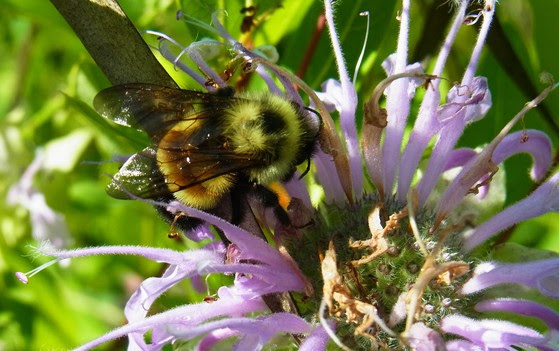June 17, 2021
Contact: Owen Boyle, DNR Species Management Section Chief
Owen.Boyle@wisconsin.gov or 608-576-2446
Eva Lewandowski, DNR Citizen-based Monitoring Coordinator
Eva.Lewandowski@wisconsin.gov or 608-264-6057
Jay Watson, DNR Conservation Biologist
Jay.Watson@wisconsin.gov or 608-354-3464
Gov. Tony Evers Proclaims June 21-27 Pollinator Week
Take Action To Help Bees & Butterflies

Wisconsin is a stronghold of federally endangered rusty patched bumble bees. Plant native plants and take other steps to help this and other pollinators. / Photo Credit: Jay Watson
MADISON, Wis. – Gov. Tony Evers has proclaimed June 21-27 Pollinator Week, and the Wisconsin Department of Natural Resources (DNR) encourages Wisconsinites to help pollinators by creating and maintaining habitat and monitoring bees and butterflies.
In his proclamation, Gov. Evers recognizes the importance of pollinators “to our environment, economy and collective well-being.” Pollinators visit flowering plants and transfer pollen from flower to flower, allowing the plants to reproduce. Wisconsin’s native pollinators include bees, butterflies, moths, flower flies, beetles, wasps and hummingbirds.
Seventy-five to ninety-five percent of all flowering plants worldwide need pollinators to help reproduce, according to the Pollinator Partnership, which organized the awareness week. In addition to providing much of the food we eat, these flowering plants feed wildlife and support healthy ecosystems that clean the air and stabilize soil. Unfortunately, populations of many pollinators, including several bumble bees and butterflies, are in decline.
“One of the biggest threats pollinators face is habitat loss,” said Owen Boyle, DNR Species Management Section Chief. “The good news is that anyone can help pollinators by creating and maintaining places where pollinators can flourish.”
Pollinators benefit from habitat creation at any scale, from a few native plants on an apartment balcony to large-scale prairie restorations. People can create habitat for pollinators to nest and get food by planting native wildflowers, minimizing or eliminating pesticide use and leaving areas unmanicured. Uncut grass, brush piles, woody debris and patches of bare earth are important pollinator habitats.
Individuals and organizations who want to create pollinator habitat can find many resources on the DNR’s Saving Wisconsin’s Native Pollinators webpages. Guides are available to help people select the native plants right for their location and maintain the habitat, and a list of native plant nurseries helps customers locate seeds or seedlings for their habitat projects.
“In addition to habitat creation, we also encourage members of the public to volunteer with one of the many monitoring projects that track the distribution and abundance of pollinators,” said Eva Lewandowski, DNR Citizen-based Monitoring Coordinator.
Volunteers can report observations or conduct formal surveys through the DNR’s Wisconsin Bumble Bee Brigade, featured in the Summer Wisconsin Natural Resources magazine; the DNR’s Karner Volunteer Monitoring Project or one of several monarch monitoring projects active in the state. These efforts help scientists understand the location and status of pollinator species in Wisconsin and inform on-the-ground conservation efforts.
Find links to monarch monitoring and habitat efforts and more information on helping pollinators on the DNR’s Saving Wisconsin’s Native Pollinators Webpages.


